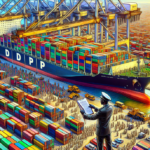Comparing DDP and DAP: A Comprehensive Guide
In the realm of international trade and e-commerce, selecting the right shipping and delivery terms is crucial for business success. Delivered Duty Paid (DDP) and Delivered at Place (DAP) are two commonly used Incoterms that businesses must understand to optimize their shipping strategies. This guide delves into the intricacies of DDP and DAP, helping you make informed decisions for your business operations.
Understanding DDP and DAP
What is DDP?
Delivered Duty Paid (DDP) means the seller assumes full responsibility for delivering goods to the buyer's premises, including all costs related to transportation, duties, taxes, and customs clearance. This term offers a seamless experience for the buyer, as they receive the goods without handling any additional import formalities.
What is DAP?
Delivered at Place (DAP) indicates that the seller is responsible for delivering the goods to a specified location, excluding the costs of duties and taxes. Once the goods reach the designated point, the buyer takes over responsibility for any subsequent expenses and customs procedures.
Benefits of Using DDP and DAP
Enhancing Customer Experience
Both DDP and DAP can significantly improve the customer experience by providing clarity on shipping costs upfront, thereby avoiding unexpected expenses. This transparency builds trust and encourages repeat business.
Global Market Expansion
By utilizing DDP and DAP, businesses can effortlessly enter new international markets. These terms simplify the complexities of cross-border shipping, enabling businesses to reach a broader customer base without the logistical nightmares commonly associated with international trade.
Compliance and Risk Management
Implementing DDP ensures compliance with international trade regulations, as the seller handles all necessary documentation and duties. Conversely, DAP allows buyers to manage their compliance processes, which can be advantageous for businesses with established import procedures.
Choosing Between DDP and DAP
When to Choose DDP
- Streamlined Operations: Ideal for businesses looking to offer a hassle-free experience to customers by managing all aspects of shipping and customs.
- Competitive Advantage: Provides a competitive edge by absorbing all shipping-related costs, making pricing more attractive to customers.
- Inventory and Supply Chain Control: Enhances control over the shipping process, reducing potential delays and ensuring timely deliveries.
When to Choose DAP
- Cost-Effectiveness: Suitable for businesses aiming to reduce shipping costs by transferring duties and taxes responsibilities to the buyer.
- Flexibility in Delivery: Allows buyers to choose convenient delivery locations, such as warehouses or distribution centers.
- Experienced in International Trade: Beneficial for businesses with expertise in handling customs clearance, ensuring efficient delivery without delays.
Key Differences Between DDP and DAP
Cost Responsibility
With DDP, the seller bears all costs until the goods reach the buyer's location. In contrast, DAP shifts some of these costs to the buyer once the goods are delivered to the agreed-upon destination.
Control Over Shipment
DDP gives sellers greater control over the entire shipping process, while DAP provides buyers with more autonomy once the goods have arrived at the specified point.
Insurance Coverage
Under DDP, sellers are responsible for insuring the shipment until it reaches the buyer's premises. With DAP, the seller's responsibility for insurance ends once the goods arrive at the designated location, potentially requiring buyers to secure additional coverage.
Implementing DDP and DAP in Your Business Strategy
Assessing Your Business Needs
Before adopting DDP or DAP, evaluate factors such as your budget, target markets, and customer base. Determine which term aligns best with your business model and operational capabilities.
Logistical Considerations
Implementing these terms requires robust logistics and a clear understanding of international shipping practices. Invest in training or hire experts to manage the complexities of DDP and DAP effectively.
Regulatory Compliance
Ensure your business complies with all relevant international trade regulations. Non-compliance can lead to fines, delays, and reputational damage. Consult reputable sources for the latest regulatory updates.
Optimizing Your Use of DDP and DAP
Effective Communication
Clearly communicate shipping terms and responsibilities to your customers to set accurate expectations. Transparency minimizes misunderstandings and enhances customer satisfaction.
Partnering with Reliable Logistics Providers
Collaborate with trusted logistics partners who have expertise in international shipping. Reliable partners ensure timely deliveries and handle complexities efficiently.
Streamlining Customs Processes
Maintain accurate and comprehensive documentation to facilitate smooth customs clearance. Staying informed about changing customs regulations in your target markets is essential.
Challenges and Solutions in Using DDP and DAP
Varying Regulations
Different countries have distinct import regulations, which can complicate shipping processes. Solution: Conduct thorough research and consult with experts to navigate these discrepancies.
Cost Management
Managing the costs associated with DDP and DAP can be challenging due to fluctuating duties and taxes. Solution: Utilize cost calculators and budget forecasting tools to anticipate and manage expenses effectively.
Supply Chain Disruptions
Unexpected disruptions in the supply chain can impact delivery timelines. Solution: Develop contingency plans and establish strong relationships with multiple logistics providers to mitigate risks.
Future Trends in the Use of DDP and DAP
Increasing E-commerce Growth
The surge in e-commerce, accelerated by the COVID-19 pandemic, is driving the adoption of DDP and DAP. Businesses are increasingly leveraging these terms to meet the rising demand for international shipping.
Technological Advancements
Advancements in logistics technology, such as AI-driven tracking and automated customs clearance, are enhancing the efficiency of DDP and DAP services.
Sustainability in Shipping
There is a growing emphasis on sustainable shipping practices. Businesses are exploring eco-friendly shipping options within DDP and DAP frameworks to reduce their carbon footprint.
Conclusion: Selecting the Right Option for Your Business
Choosing between DDP and DAP depends on your business objectives, resources, and target markets. DDP is ideal for businesses seeking to provide a seamless customer experience by managing all aspects of shipping and customs. Conversely, DAP offers cost savings and flexibility, making it suitable for businesses with the capability to handle import responsibilities. Carefully evaluating your needs and consulting with experts will help you make the best decision for your business's international shipping strategy.






















